Genre blending is reshaping the landscape of media consumption by merging elements from various genres, thereby appealing to a wider audience. This innovative approach not only enhances consumer engagement but also drives trends in digital products, reflecting a growing demand for unique experiences. As technology advances and cultural exchanges flourish, the traditional boundaries of genres continue to dissolve, creating a vibrant and dynamic marketplace.
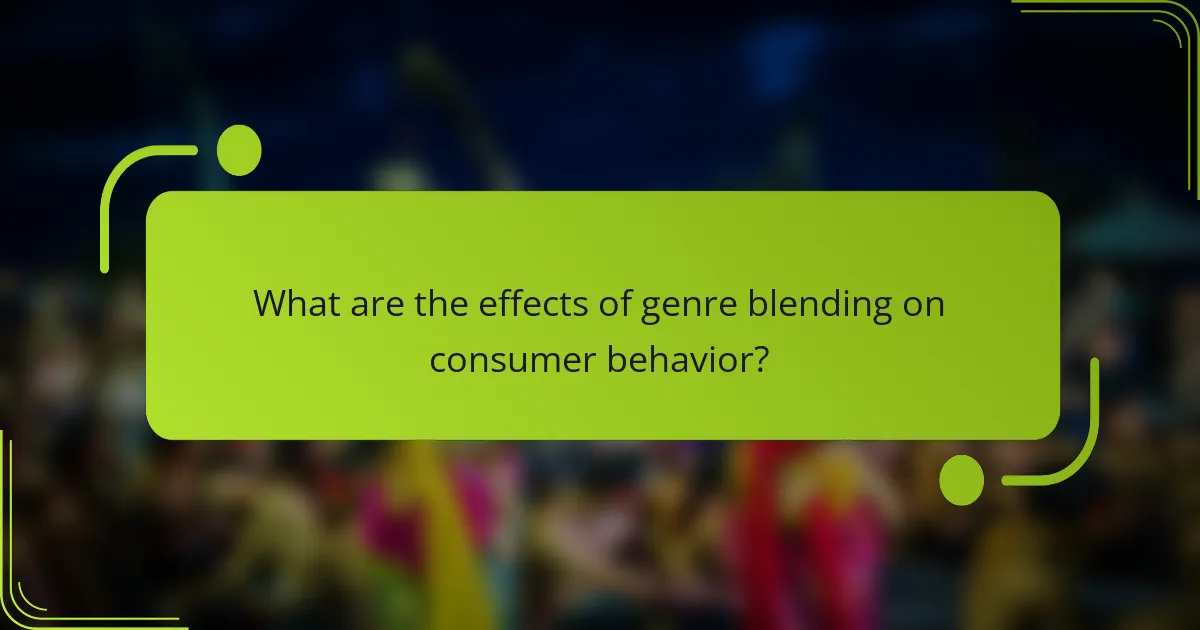
What are the effects of genre blending on consumer behavior?
Genre blending significantly influences consumer behavior by expanding the range of content that attracts audiences. This fusion creates new experiences that resonate with diverse preferences, ultimately shaping how consumers engage with and purchase media products.
Increased engagement with diverse content
Genre blending leads to higher engagement as consumers are drawn to innovative combinations of styles and themes. For instance, a film that merges elements of horror and comedy can appeal to fans of both genres, increasing viewership and discussions around the content.
This engagement is often reflected in social media interactions, where audiences share their experiences and recommendations, further amplifying interest in blended genres. Streaming platforms have noted that titles with mixed genres tend to achieve higher completion rates among viewers.
Shift in purchasing patterns for digital products
As genre blending becomes more prevalent, consumers are shifting their purchasing habits, favoring digital products that offer unique, hybrid experiences. For example, video games that combine role-playing elements with action mechanics have gained popularity, leading to increased sales in these categories.
Consumers are now more willing to invest in subscription services that provide access to a variety of blended content, reflecting a preference for flexibility and diversity in their media consumption. This trend suggests that businesses should consider offering bundled services or products that cater to these evolving tastes.
Enhanced emotional connection to hybrid genres
Genre blending fosters a deeper emotional connection as it allows consumers to relate to multiple aspects of a narrative or experience. For instance, a romantic drama with elements of science fiction can resonate with viewers on different emotional levels, making the story more relatable and impactful.
This emotional engagement can lead to increased loyalty towards creators and brands that successfully blend genres, as consumers feel a personal connection to the content. Marketers should leverage this emotional appeal by highlighting the unique aspects of blended genres in their promotional strategies.
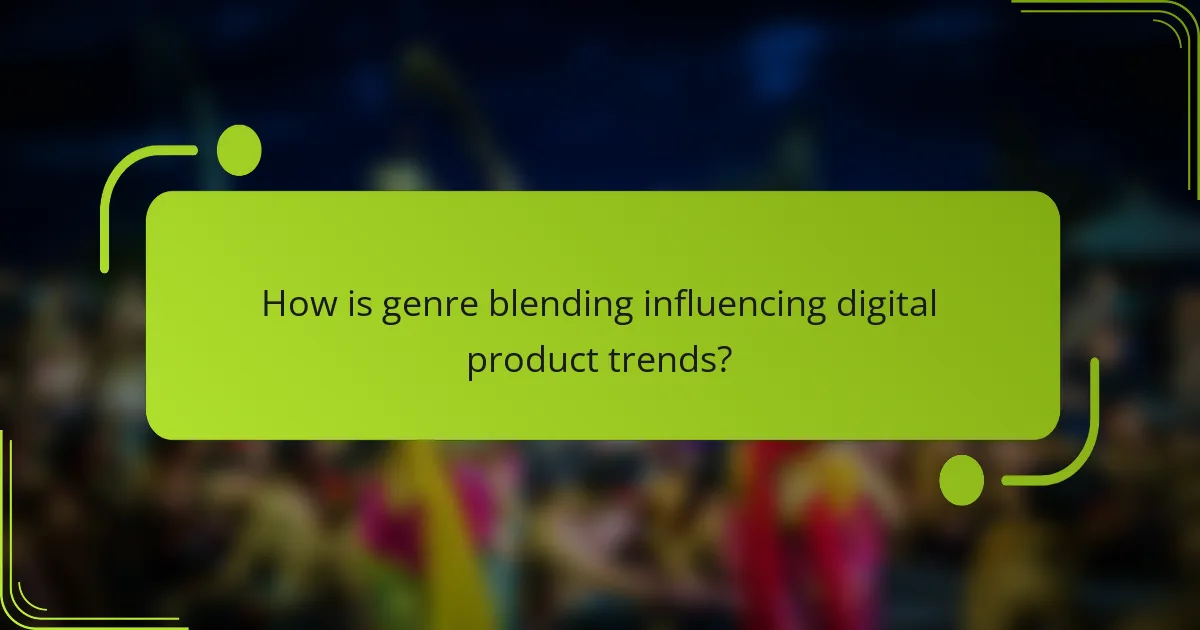
How is genre blending influencing digital product trends?
Genre blending is significantly shaping digital product trends by creating innovative experiences that attract diverse consumer segments. This approach allows creators to combine elements from various genres, resulting in products that cater to broader tastes and preferences.
Rise of hybrid video games
Hybrid video games are gaining traction as developers merge gameplay mechanics from different genres, such as role-playing and first-person shooters. This fusion enhances player engagement by offering varied experiences within a single game, appealing to fans of multiple genres.
Popular examples include titles like “Fortnite,” which combines battle royale elements with building mechanics, and “The Legend of Zelda: Breath of the Wild,” which integrates open-world exploration with puzzle-solving. These games demonstrate how genre blending can create compelling gameplay that keeps players invested.
Popularity of genre-crossing music albums
Genre-crossing music albums are increasingly popular as artists experiment with blending styles like pop, hip-hop, and electronic music. This trend reflects consumers’ desire for fresh sounds and diverse listening experiences, leading to collaborations that push traditional boundaries.
For instance, albums like “Lemonade” by Beyoncé and “Awaken, My Love!” by Childish Gambino showcase a mix of genres, attracting listeners from various musical backgrounds. Such projects not only broaden an artist’s audience but also encourage innovation within the music industry.
Emergence of mixed-media storytelling
Mixed-media storytelling is on the rise as creators combine text, visuals, and audio to craft immersive narratives. This approach engages audiences by leveraging multiple formats, making stories more dynamic and accessible across different platforms.
Examples include graphic novels that incorporate augmented reality elements or podcasts that feature interactive websites. These formats allow consumers to experience stories in unique ways, enhancing emotional connections and expanding narrative possibilities.
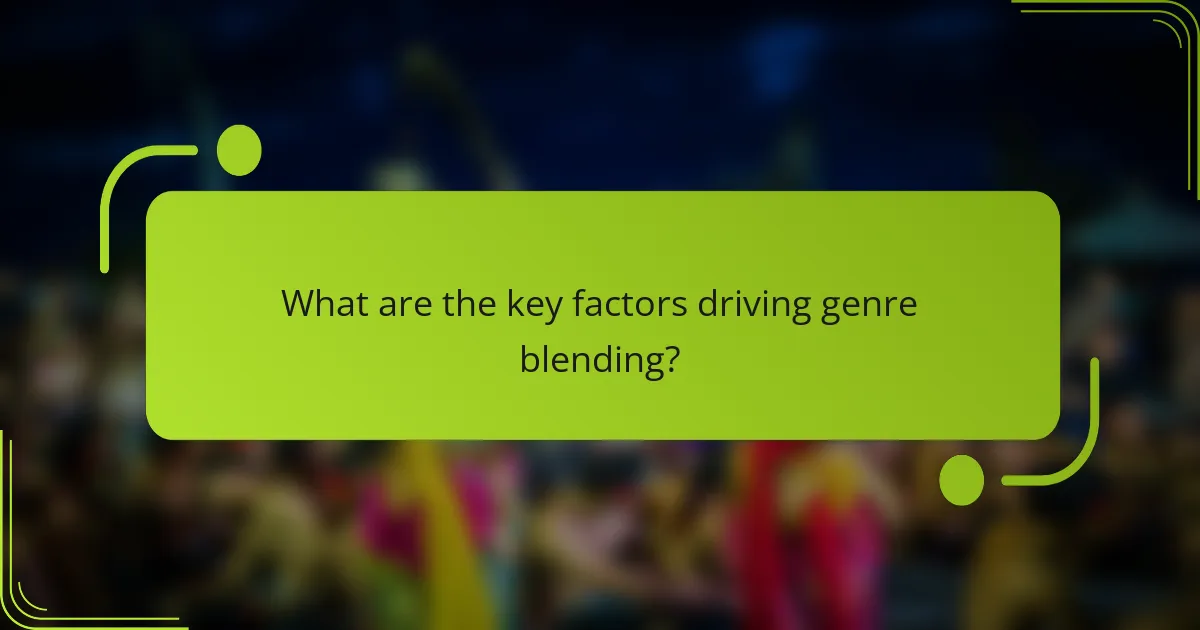
What are the key factors driving genre blending?
Key factors driving genre blending include technological advancements, consumer demand for unique experiences, and cultural exchange facilitated by globalization. These elements work together to create a dynamic landscape where traditional genre boundaries are increasingly blurred.
Technological advancements in content creation
Technological advancements play a significant role in genre blending by providing creators with innovative tools and platforms. For instance, software for music production allows artists to mix various styles effortlessly, leading to genres like electronic rock or hip-hop fusion. Additionally, streaming services enable easy access to diverse content, encouraging experimentation across genres.
Moreover, virtual reality (VR) and augmented reality (AR) technologies are transforming storytelling, allowing creators to blend gaming, film, and interactive experiences. This convergence not only enhances engagement but also opens up new avenues for genre innovation.
Consumer demand for innovative experiences
Consumers increasingly seek innovative experiences that challenge traditional genre norms. This demand drives creators to experiment with genre blending, resulting in fresh and engaging content. For example, the rise of hybrid genres in film, such as romantic comedies with horror elements, reflects this desire for unique storytelling.
Furthermore, audience engagement on social media platforms influences trends in genre blending. Users often share and promote content that defies categorization, pushing creators to explore unconventional combinations that resonate with viewers.
Cultural exchange and globalization
Cultural exchange and globalization are significant factors in the rise of genre blending. As cultures interact more than ever, artists draw inspiration from diverse traditions, leading to the creation of new hybrid genres. For instance, K-pop has successfully integrated elements from Western pop, hip-hop, and electronic music, appealing to a global audience.
Additionally, international collaborations between artists from different backgrounds foster genre innovation. These partnerships often result in unique sounds and styles that reflect a blend of cultural influences, further enriching the landscape of genre blending.
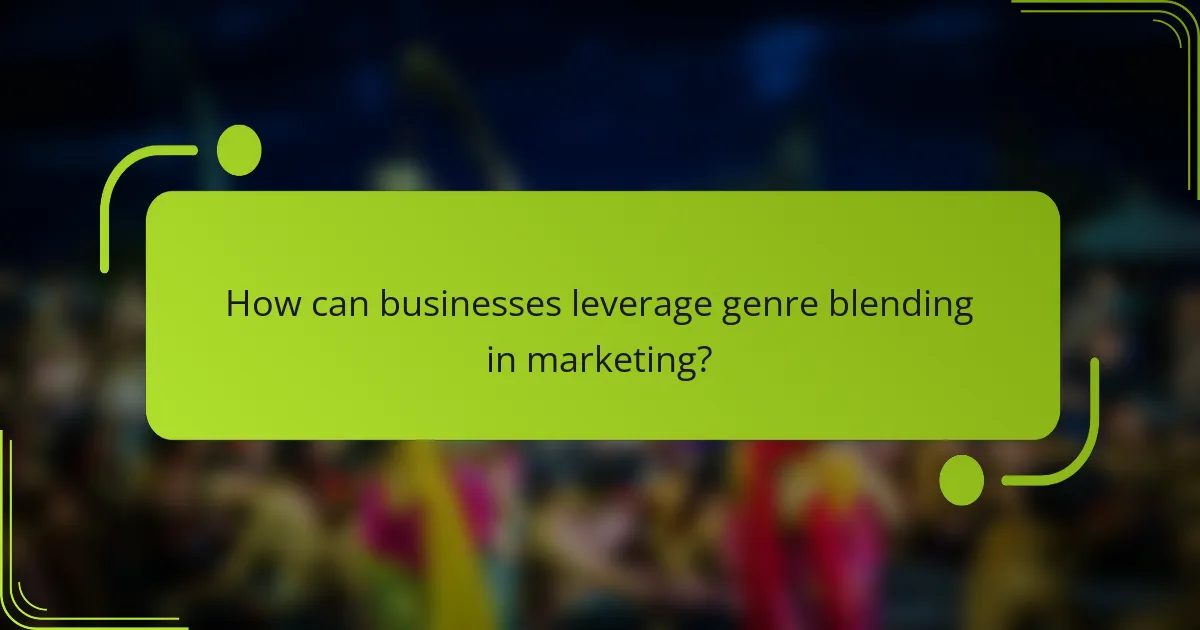
How can businesses leverage genre blending in marketing?
Businesses can effectively leverage genre blending in marketing by creating unique campaigns that resonate with diverse consumer interests. This approach allows brands to reach wider audiences and foster deeper connections by combining elements from different genres, leading to innovative and engaging marketing strategies.
Target niche audiences with tailored campaigns
Identifying niche audiences is crucial for successful genre blending. By analyzing consumer preferences and behaviors, businesses can craft tailored campaigns that speak directly to specific groups. For instance, a brand might combine elements of horror and comedy to appeal to fans of both genres, creating a unique promotional experience.
Utilizing data analytics tools can help businesses uncover insights about their target demographics. Consider segmenting your audience based on interests, age, or lifestyle to develop campaigns that resonate on a personal level. This targeted approach can significantly enhance engagement and conversion rates.
Create cross-genre collaborations
Cross-genre collaborations can amplify brand visibility and attract new customers. By partnering with creators or brands from different genres, businesses can produce innovative content that appeals to a broader audience. For example, a fashion brand might collaborate with a popular video game to create themed merchandise, merging the worlds of fashion and gaming.
When planning collaborations, ensure that both parties share similar values and target audiences. This alignment can enhance authenticity and increase the likelihood of a successful partnership. Consider co-hosting events or launching joint marketing campaigns to maximize impact.
Utilize social media for genre fusion promotion
Social media platforms are ideal for promoting genre fusion due to their vast reach and interactive nature. Brands can create engaging content that showcases their genre-blending efforts, such as videos, memes, or polls that invite audience participation. This not only boosts visibility but also encourages community engagement.
Utilize hashtags and trends relevant to both genres to increase discoverability. Engaging with followers through comments and shares can further enhance brand loyalty. Regularly analyze engagement metrics to refine your approach and ensure your content resonates with your audience.
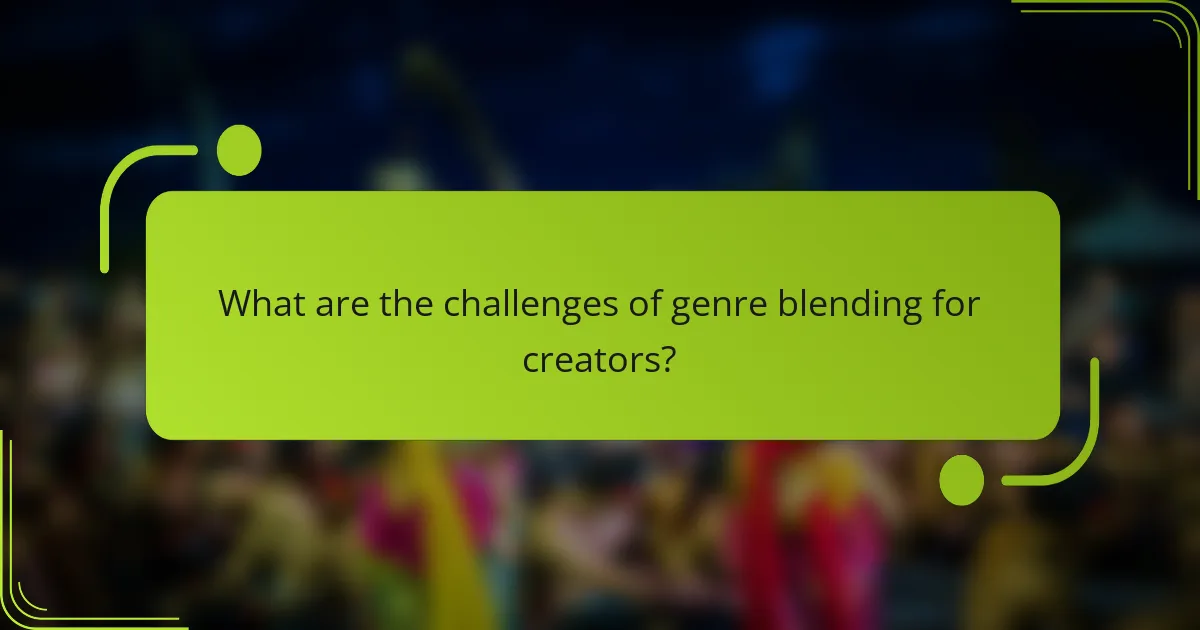
What are the challenges of genre blending for creators?
Creators face several challenges when blending genres, including meeting audience expectations, navigating copyright issues, and maintaining their artistic vision. Successfully addressing these challenges is crucial for producing innovative works that resonate with diverse audiences.
Balancing audience expectations
Balancing audience expectations is vital for creators venturing into genre blending. Fans often have preconceived notions about what a particular genre should deliver, and straying too far can alienate them. For example, a horror-comedy film must maintain enough suspense to satisfy horror fans while delivering humor that appeals to comedy lovers.
To navigate this, creators should conduct market research to understand their target audience’s preferences. Engaging with fans through social media or surveys can provide valuable insights into what elements are most appealing.
Navigating copyright and licensing issues
Copyright and licensing issues present significant hurdles for creators blending genres. When incorporating elements from existing works, creators must ensure they have the proper permissions to avoid legal disputes. This is especially true when mixing genres that have distinct intellectual property rights, such as combining a popular fantasy series with a well-known sci-fi franchise.
To mitigate risks, creators should consult legal experts familiar with copyright laws in their region. Establishing clear agreements and understanding the scope of fair use can help navigate these complexities effectively.
Maintaining artistic integrity
Maintaining artistic integrity is essential for creators who blend genres, as it can be easy to compromise one’s vision in pursuit of broader appeal. Striking a balance between commercial success and personal expression is often challenging. For instance, a musician blending rock and jazz might face pressure to conform to mainstream trends, risking their unique sound.
Creators should stay true to their artistic vision by setting clear objectives for their projects. Regularly revisiting these goals can help ensure that the final product reflects their intended message and style, even when experimenting with different genres.
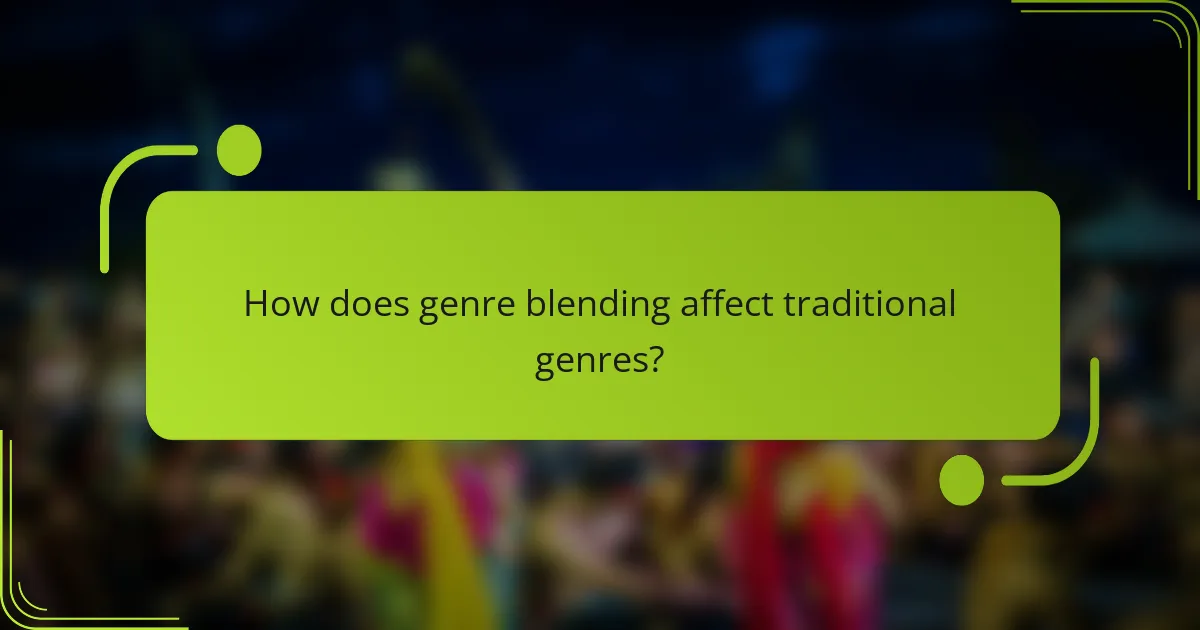
How does genre blending affect traditional genres?
Genre blending significantly alters traditional genres by merging elements from different styles, creating new experiences for audiences. This fusion challenges established norms and encourages innovation, leading to a dynamic landscape in media and entertainment.
Redefinition of genre boundaries
Genre blending blurs the lines between established categories, allowing creators to experiment with various elements. For instance, a film that combines horror and comedy, like “Get Out,” redefines what audiences expect from both genres. This redefinition can lead to the emergence of hybrid genres, such as romantic thrillers or sci-fi dramas.
As genres evolve, audiences become more open to diverse storytelling methods, which can enhance engagement and broaden viewership. This shift encourages creators to push boundaries and explore new narratives that may not fit neatly into traditional classifications.
Impact on genre-specific marketing strategies
Marketing strategies must adapt to the complexities of genre blending, as traditional approaches may not resonate with audiences seeking hybrid experiences. For example, a campaign for a genre-blended film might highlight both its comedic and thrilling elements to attract a wider audience. This dual focus can increase interest and ticket sales.
Marketers should consider using targeted messaging that reflects the unique aspects of blended genres, utilizing social media and influencer partnerships to reach diverse demographics. Understanding the audience’s preferences is crucial for effective promotion in this evolving landscape.
Influence on award categories and recognition
As genre blending becomes more prevalent, award categories may need to adapt to recognize innovative works that defy traditional classifications. For instance, films or books that combine multiple genres might struggle to fit into existing award categories, leading to calls for new distinctions that celebrate hybrid creations.
Organizations may consider introducing awards specifically for genre-blending achievements, acknowledging the creativity and risk-taking involved in such projects. This recognition can encourage more artists to explore genre fusion, further enriching the cultural landscape.


